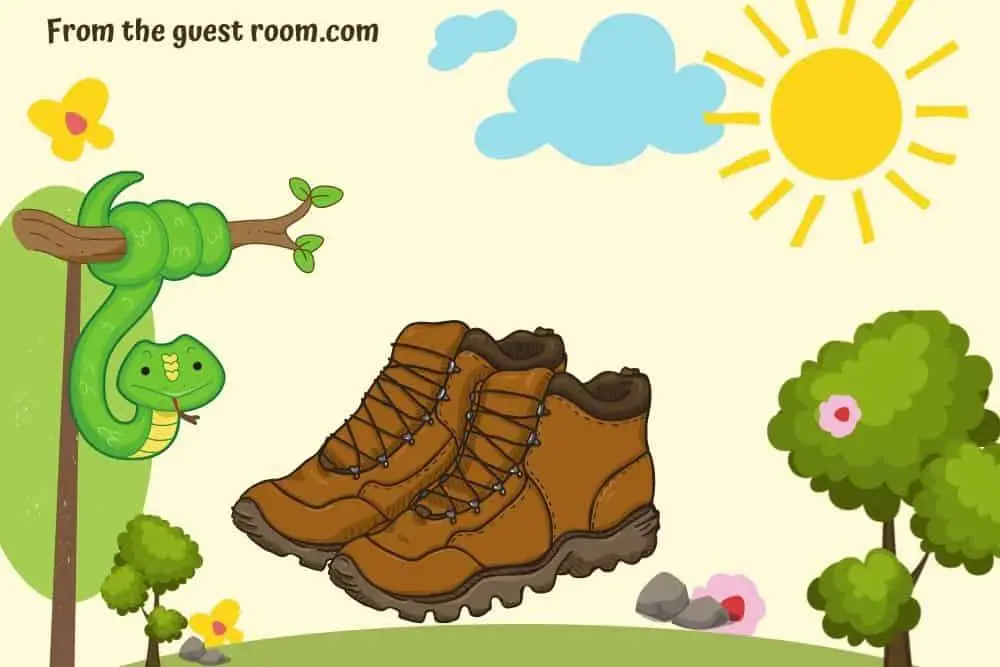On a hiking trail, you are likely to come across different creatures, one of which is snakes. But, of course, snakes are not on every trail you hike, but they give hikers the jitters.
No one wants to encounter snakes on the trail, or worse, experience bites from one. Your chances of encountering snakes on the trail are slim, but one can’t be too careful.
Generally, snakes depend on external sources of heat to regulate their body temperature. Therefore, you are more likely to find them on the trail early in the morning or evening.
During the day, they usually hide from the sun, so they usually rest under rocks, leaf litter, debris, streams, creek edges, or tree canopies.
Sometimes, they even notify people of their presence through hisses, huffs, or rattling, and other times, they don’t. This is why hikers need to be careful to prevent snake bites.
Apart from being careful, wearing protective hiking gear can help as well. This brings the question, “Do hiking boots prevent snake bites?” on the trail.
Sure, hiking boots protect you on the trail from insects, debris, and critters, but do they protect against snake bites? It is possible, but why don’t you find out in this article?
Read on to find out.
Contents
Do Hiking Boots Prevent Snake Bites?
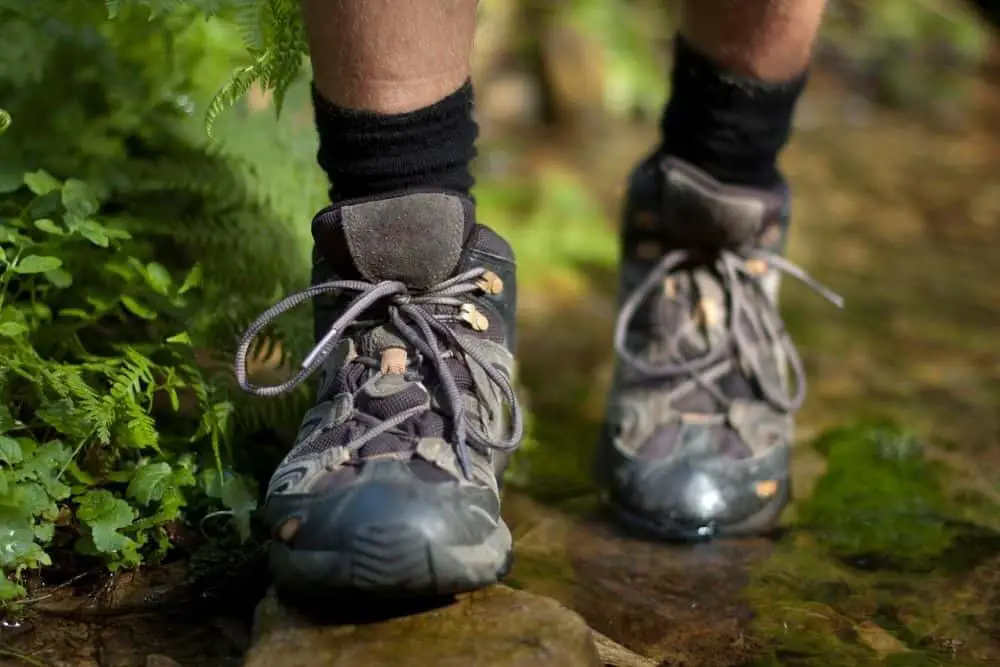
Hiking boots may prevent snake bites, but they don’t guarantee 100% protection. However, this depends on different factors.
On the trail, you are likely to encounter rattlesnakes, cottonmouths, copperheads, water moccasins, coral snakes, or other vipers, which are harmful and are likely to release venom into their victims. Therefore, you want to watch out for them.
Sometimes, they may not release venom, which is an estimate of 25% to 50% of their bites. As opposed to popular belief that you can tell venomous snakes from their color of head shapes, it is not always so.
To an extent, hiking boots can prevent snake bites. But, it depends on the type of boots they are, how large the snake is, and the size of their fangs. Moreover, hiking boots can deflect snake bites.
If the snakes have short fangs, they can hardly penetrate the layers of hiking boots’ outer materials, but not in all cases. And if the fangs are longer, they can puncture the boots and the skin.
For example, some vipers’ fangs are like hypodermic needles, and they are likely to penetrate hiking boots. However, quality hiking boots can deflect the effectiveness of snake bites.

A rattlesnake, for example, has a bite of about 120-150 PSI (pounds per square inch), depending on how big the snake is. This can penetrate boots unless they are snakeproof boots, and some can reach the skin beneath the layers of hiking boots.
However, this depends on the type of hiking boots you wear. Hiking boots with thick layers are more likely to prevent or reduce snake bites’ impact.
For example, their material also needs to be strong, like leather or nylon. They can mask off heat that may emanate from your feet since snakes draw to heat sources.
In addition, you need hiking boots that protect not just your feet but also some parts of your legs. Hiking boots are not knee-high, so you cannot expect them to protect your leg up to that level.
However, hiking boots with high-cut designs can surely protect your leg up to the level above your ankle. And lower designs leave the other parts susceptible to snake bites.
But you cannot always count on your boots to protect you completely from snake bites, so you have to play your part as well. You have to reinforce your boots with what you wear as well and be careful on the trail.

As stated earlier, some snakes lay low on the trail, and this is why you have to be careful. Ensure you check around you before you make some moves on the trail, especially if you are hiking in a bushy area or in the woods.
In addition, you should be careful sticking your hands around places on the trail so the snakes don’t attack your hands instead of your feet.
Likewise, long pants will serve you well if you are hiking on trails that are home to snakes so that they can cover your leg to an extent, and your boots can protect your feet.
The right footwear on the trail will prevent snake bites to a certain extent, which is why you should wear hiking boots often other than other footwear. You should also research trails on your part to know if they are homes to snakes.
How Do Hiking Boots Prevent Snake Bites?
Hiking boots can prevent snake bites on the trail to an extent, but they are not completely protective. They can protect you from being affected by snake bites thanks to some of their features.
Although originally, manufacturers didn’t add these features to hiking boots to prevent snake bites, they can also serve that purpose. Those features are:
Tall uppers

Tall uppers are part of the hiking boot design, and they help with ankle support and comfort on the trail. Mostly, people wear them for the support they provide on the trail, but they can do more than that on the trail, especially now that snakes are involved.
Mid-cut and high-cut hiking boots have taller uppers than hiking shoes, which are more protective. But in this case, the higher the uppers, the more they can prevent snake bites on the trail.
If snakes bite you near that location, you may be able to get some protection. However, the length of the hiking boots’ uppers is as long as they protect you from snake bites on the trail.
If the snake were to attack you from above the area, they could dig their fangs directly into your skin. Here, you would need your clothes to protect you, but there’s only a little bit your pants can do.
Therefore, if you know you’re going hiking in a snake-infested area, you’re better off with snake-proof boots than just hiking boots.
Rubber sole
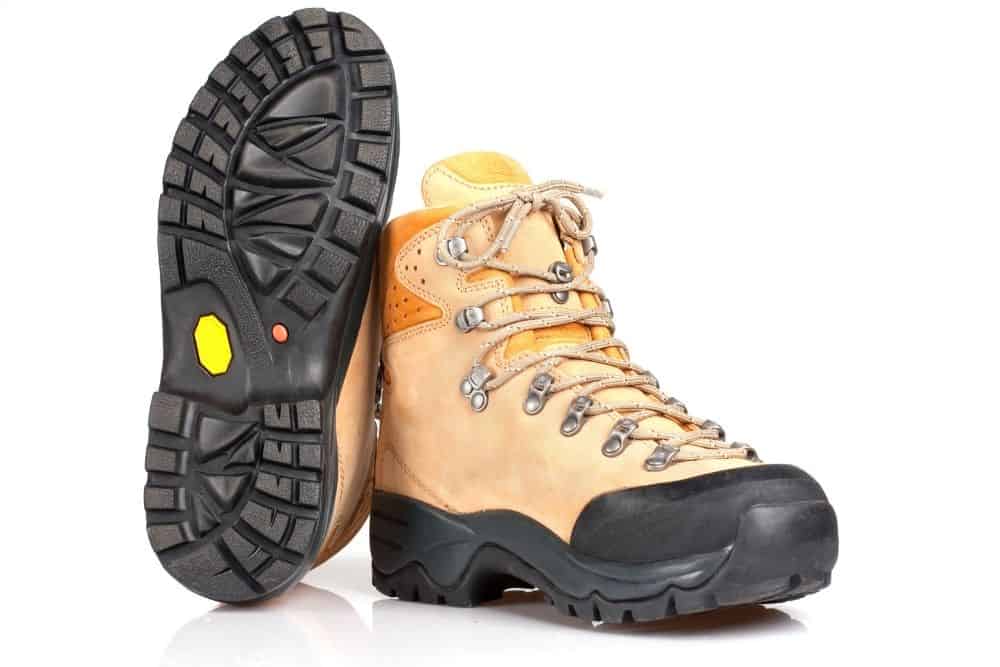
Rubbers are very tough in preventing snake bites and fangs from getting into your skin. They are usually made from tough materials, which make their fangs impenetrable.
And with rubber as the soles, they can prevent snake bites to an extent. While on the trail, snakes can camouflage with the ground, and the most vulnerable part of your legs is your feet.
You can be walking next to a snake without your knowledge, and it may be prompted to bite your feet, but the rubber soles can prevent their fangs from penetrating. Usually, their fangs may not go beyond the rubber sole enough to reach your skin.
Snakes are not exactly concerned about whether they have successfully bitten you, so once they strike, they are out of your way. The only way rubber soles may not be effective is if snakes attack you from other places apart from the uppers.
Other parts of your hiking boots may leave you susceptible to snake bites depending on how tough they are.
Upper material
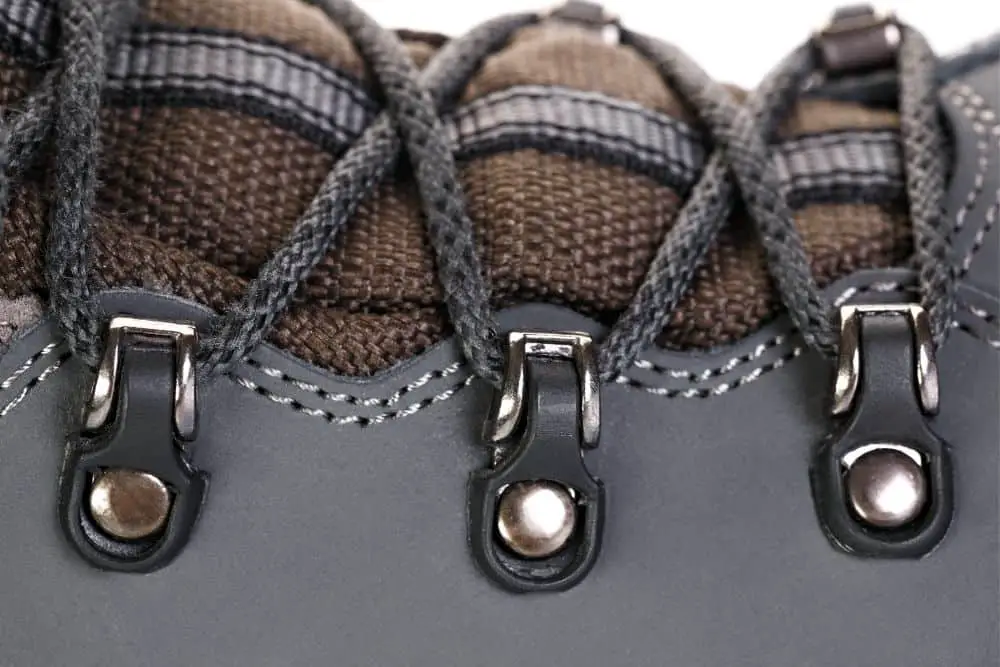
Another hiking boot feature that prevents snake bites is their upper materials. Light materials cannot do much to hold snake fangs, but you get a bit of protection with thicker and tougher materials.
Hiking boots with leather or nylon material can help to protect your feet from snake fangs. They are tough and thick and can deflect snake fangs to a large extent.
Leather can bounce off their bite and prevent their fangs from penetrating. However, they are not completely effective. In addition, they stop eating emanating from your body, preventing snakes from drawing near you on the trail.
Toe cap
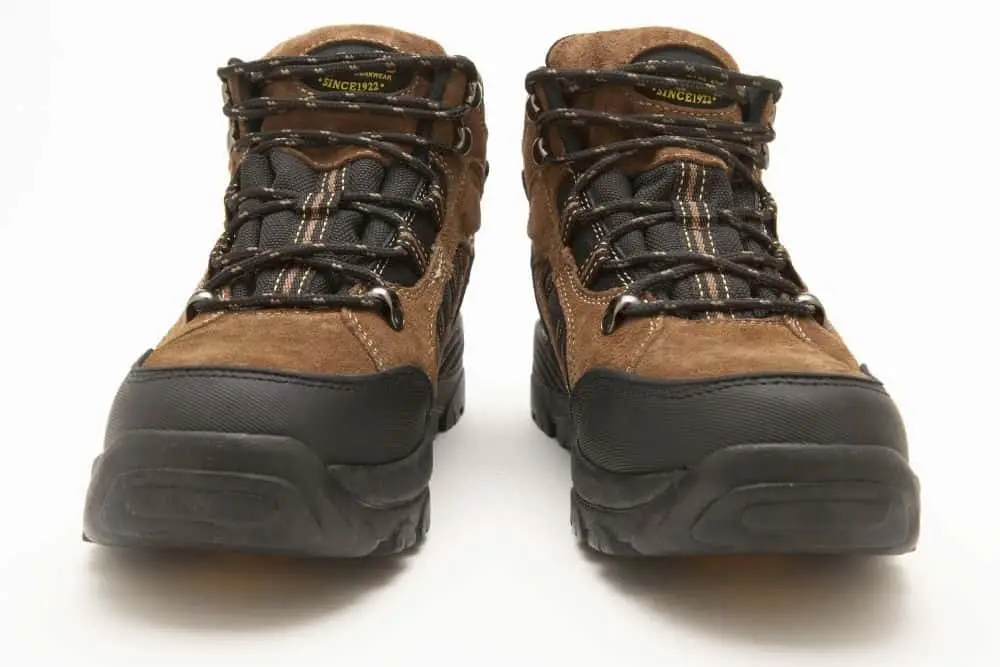
Hiking boots’ toe caps can also prevent snake bites on the trail. The main purpose of toe caps in hiking boots is to prevent impacts on the toes, but they can also prevent snake bites in that area.
These toe caps are made from composite materials like heavy-duty plastic, rubber, or carbon fiber. This helps restrict the snake fangs from getting to or impacting your toes.
However, the toe cap is not enough to protect your feet on the trail because other parts of the feet are left vulnerable.
Can A Snake Bite Through Hiking Boots?
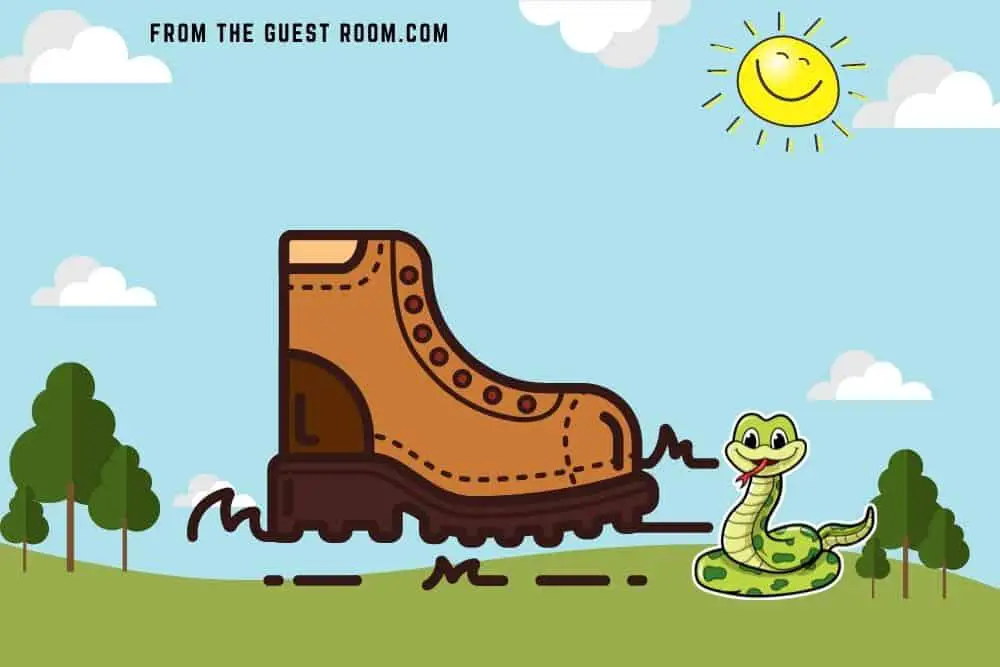
Yes, snakes can bite through hiking boots. However, that depends on the boots, the snake’s size, and its fangs. If the hiking boots’ materials are not thick or tough, snakes can bite through them and even penetrate your skin.
If the hiking boots’ fabric is mesh, the fangs can easily tear through and get to your feet. However, if the material is tough and has more than one layer, then the snake fangs will have a tough time biting through the boots.
If the material of the hiking boot is leather or nylon, the snake can hardly bite through it. As long as the boots have thick layers, the chances of bites are less likely.
Can rattlesnakes bite through leather hiking boots?
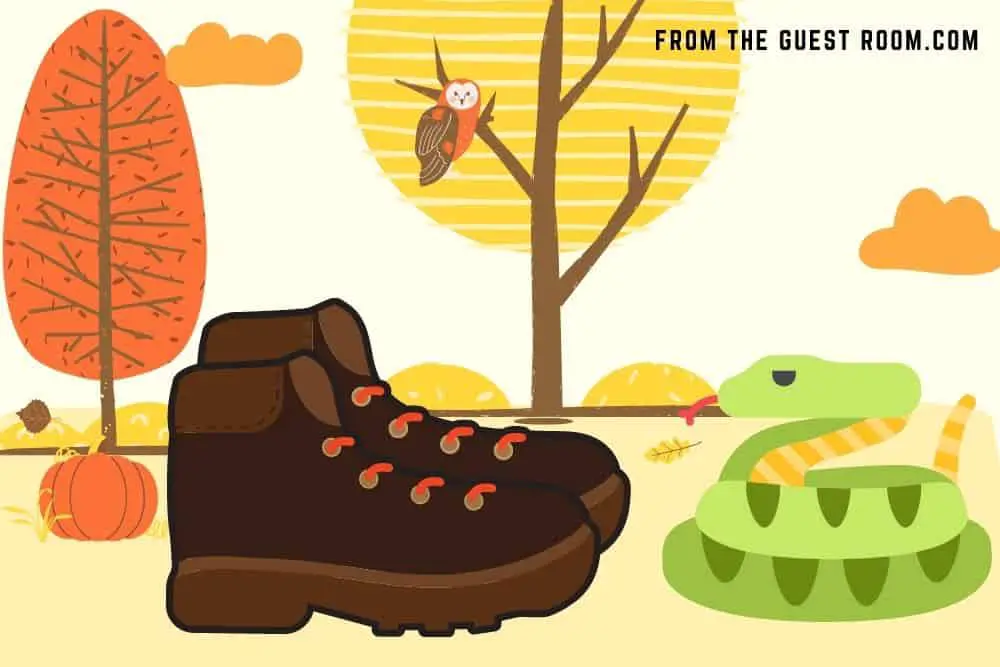
Rattlesnakes can hardly bite through leather hiking boots, however, not in all cases. If it is just a glancing bite, the rattlesnake’s fangs may not go through the leather and just bounce off.
Although leather hiking boots have a level of protection against rattlesnakes, they are not totally snakeproof. Therefore, snakes can bite through leather hiking boots unless they are snake-proof.
Rattlesnakes have between 120 and 150 PSI, and their fangs can penetrate hiking boots, depending on their size. However, small rattlesnakes with small fangs may not be able to bite through leather hiking boots, but it may not be the same for large rattlesnakes.
Conclusion
Hiking boots prevent snake bites on the trail, but it depends on the type of boots they are on and the size of the snake and its fang. Snakes with longer fangs can bite through hiking boots, especially if they are not snakeproof.
But to an extent, hiking boots can prevent snake bites due to their features like tall uppers, leather or nylon materials, toe caps, and rubber soles. If you want to completely protect yourself from snake bites on the trail, you are better off hiking on trails void of snakes.
Therefore, you should research the trails before setting out. And if you must hike on those trails, wear boots that are snake-proof.

